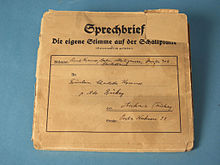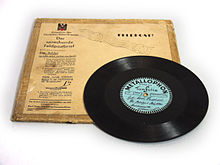Speaking letter
The speaking letter is a record on which a message of greeting could be recorded using a microphone and which the recipient could listen to on a gramophone . The speaking letter was usually one minute long, contained between 130 and 140 words, and was considered a common, albeit expensive, alternative to telegrams and postcards in the 1930s . In the context of the war in the early 1940s, it was called the Speaking Field Post Letter . The term used internationally is Fonopost .
history
A forerunner of the spoken letter was the post-phonogram of the American inventor Thomas Alva Edison . In 1877 Edison discussed two of his foil rollers ( Edison rollers ) - one with a greeting to his business partner in London, the other with a promotional message to the English public. At the Berlin radio exhibition in 1931, the German electronics company AEG presented a voice mail machine , in which, after inserting a coin, a record could be discussed and then sent by post as a “speaking letter”. This had become technically possible because at that time home devices for recording records came onto the market and for the first time offered customers the opportunity to record sounds themselves. However, until 1935 these clay foil cutters, which were also manufactured in compact form, were too expensive for private households at around 1,000 Reichsmarks and did not catch on.
First speaking letter from the Reichspost
At the beginning of August 1938, the Reichspost, in cooperation with the manufacturer of entertainment electronics C. Lorenz, officially introduced the spoken letter as a postal message carrier. The procedure is described in the technical in-house communications, the "Lorenz Reports", of December 1938:
“The customer goes into a soundproof cell and uses the dynamic Lorenz moving coil microphone to discuss the record into which the record cutter is cutting the text. In a special cell he can then listen to the discussed text [...]. The confidentiality of the correspondence is maintained, as an outsider cannot overhear either while discussing or listening to the records. Immediately after the meeting, the record is ready for dispatch. "
Post office 1 in Berlin-Charlottenburg set up the first speech letter box. This postal service mainly found interested parties who sent voice letters overseas. The recording was technically done on a metallophone or decelith record ; According to Lorenz, the final sound carrier was particularly insensitive to weather conditions and was "therefore also tropicalized".
Typical content of a speech letter
The envelope shown above contains a record with the inscription: "In memory of December 1938 or mother and father December 8, 1938". The text recorded on the record reads:
“Father's voice: 'Oral for a change, dear Lotte. Your signs of life are to us, it should be emphasized again and again, rays of light in our evening sun. In the days of rest that lie ahead, our thoughts linger with you particularly often, especially since with Kurt's condition one hardly needs to have immediate fears. We are also very pleased about your physical well-being; Nevertheless, you hardly have to worry about a Turkish female format. And now comes mother ... 'Mother's
voice:' Well me, dear Lotte. What do I say, really something clever. When we are resurrected after fifty years, all we have to do is make a long distance call and then have long-term calls around the world. Well, let's write another twenty years and we would like to experience them in reasonably health with our six satellites. In this sense, sincerely, mother. '"
Noises and voices in the background conclude the recording.
The record is a silver cutting foil with the inscription “unbreakable and tropicalized”.
The speaking letter as a tone variant of the field post
The speaking letter in World War II was usually longer, up to about 5 minutes. He played a role, if not an important one, among other things as an instrument of the propaganda companies , which presented "sounding company archives" with spoken stories of bravery and success, which however never came to be. The German Red Cross DRK also made use of speaking letters - mostly called "speaking field post" because of their similarity to written field post . These recordings have a more personal character. Apart from a few copies, mostly sent by soldiers to relatives who stayed at home before Christmas, only a few spoken letters have been received. The largest bundle is in the German Broadcasting Archive . Here is the description of a typical speech letter from the DRK:
"(Clear throat) Shallow light music, about it (O-Ton) Diether Hertel, shock troop leader:" My dear ones! I have just carried out a raid operation, it had been a glorious sunny day for a long time. The shock troops have worked their way up wonderfully ”/ The right shock troop caused me sorrow, so I triggered the barrage of the heavy weapons /“ It was (!) Fantastic, grenades (?) Flew, the Russian bunkers landed in the air, the first Prisoners stagger back, partly wounded ”/ It was a success as I expected from my men,“ because despite what they have been through, they are decent guys ”/ Unfortunately I also have a dead man / Now is it's all over and we celebrate the success / I'm proud of my currency company / I'm slightly blue / "
Fonopost and later versions of spoken letters
The spoken letter was known as “Fonopost” in South America (Argentina), but also in the Netherlands and Japan. In 1939 the New York Times reported in its philately section on three postage stamps announced by the Argentine Post, called "fono-post stamps" worth 4, 5 and 6 pesos, which cover the cost of recording and mailing "flexible phonograph records "Should cover:
"The plan is to set up recording machines in the post offices where customers can speak, pay for the necessary stamps and have their messages sent out."
In the 1970s, self-recorded private messages experienced a brief renaissance in the form of the cassette letter. The recording medium for this was the compact cassette .
The speaking letter should not be confused with the verdict, the official letter of judgment from a judge to a private recipient. In dictionaries prior to 1900, “speech letter” can sometimes be found, always with a reference to “spell letter”.
literature
- Handheld dictionary of postal services . 2nd Edition; P. 686.
Web links
Individual evidence
- ↑ Der deutsche Rundfunk , Issue 34, September 1931, p. 4
- ↑ For comparison: a bank clerk earned around 300 Reichsmarks in 1934.
- ↑ Quoted orally for a change, dear Lotte. In: The archive . 2/2003 of the DGPT
- ^ Lorenz reports. Technical in-house communications from C. Lorenz Aktiengesellschaft, No. 3/4, December 1938.
- ↑ Speaking letter from Hauptsturmführer Diether Hertel, from July 1943. Length 4:07 minutes. Signature K002058771. The indexing text of the German Broadcasting Archive quotes the soldier's words verbatim only in the specially marked places and otherwise paraphrases them in summary. The privately owned voice letter is in the original on a Decelith sound foil that can be played from the inside out (!) At 78 revolutions per minute . Because of its unique character, the plate also has a serial number, namely 420 16.
- ^ The New York Times. August 27, 1939. (translated from the American)


